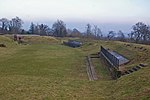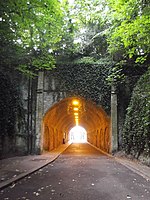Reigate transmitting station

Reigate transmitting station is a television and radio transmitting tower in southeastern England. It is located on the North Downs at Reigate Hill about one mile (1.6 km) north of the town of Reigate at junction 8 of the M25 motorway where it intersects with the A217 road. Another telecommunications tower is located adjacent to the Reigate broadcasting tower, both sites are owed and operated by Arqiva. The station was primarily built to provide uhf television to the towns of Reigate and Redhill which are screened from the London transmitter at Crystal Palace by the North Downs. However, from its high position on Reigate Hill (site height 226 metres (741 ft)) the transmitter provides secondary coverage to a large area of south Surrey and northern areas of West Sussex. The original tower built in 1966 was some 46m in height. In the late 1990s with the need to add additional services to the tower, such as digital radio, the tower was replaced with a new structure some 18m taller.
Excerpt from the Wikipedia article Reigate transmitting station (License: CC BY-SA 3.0, Authors, Images).Reigate transmitting station
Fort Lane, Reigate and Banstead
Geographical coordinates (GPS) Address Nearby Places Show on map
Geographical coordinates (GPS)
| Latitude | Longitude |
|---|---|
| N 51.25417 ° | E -0.2 ° |
Address
Fort Lane
RH2 9RN Reigate and Banstead
England, United Kingdom
Open on Google Maps








